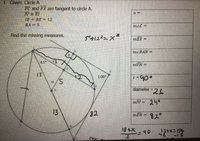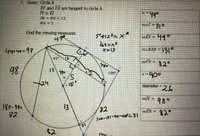You are using an out of date browser. It may not display this or other websites correctly.
You should upgrade or use an alternative browser.
You should upgrade or use an alternative browser.
Finding missing measures within a circle
- Thread starter Qwo127
- Start date
pka
Elite Member
- Joined
- Jan 29, 2005
- Messages
- 11,978
It is not at all clear to me what some of your variables are? i.e. what is \(u~?\)I’m really confused on how to find the rest of these measures...View attachment 17430
It is clear that \(m(\angle AIB)=49^o\) is that \(u~?\)
Why do you have \(m(\widehat{IV})=24^o~?\)
pka
Elite Member
- Joined
- Jan 29, 2005
- Messages
- 11,978
Good enough.u is an angle that needs to be found and it would angle BAI, in terms of points on the circle, and I have (IV) as 24 because IE is congruent to IV. The total measure of IE is 12+12 = 24 , so then since IE and IV are equal then they are both 24.
\(m(\widehat{IX})=49^o\)
\(m(\widehat{XEN})=131^o\)
\(m(\widehat{VN})=180^o-m(\widehat{IV})\)
So, the arc length of IV is not equivalent to its length? So, if its not 24 how do you find the length? But, yes, I’m trying to find the arc length of IV.IE is 12+12 = 24 , so then since IE and IV are equal then they are both 24. This is true, but the question is what is 24. The answer is the length of IE is 24. You were ask for the arc length of IV
Last edited:
Steven G
Elite Member
- Joined
- Dec 30, 2014
- Messages
- 14,603
Doesn't the arc length look longer? Have you ever heard that the shortest distance between two points is a straight line?
Seriously, if you had to walk from I to V and was in a very big rush would you walk along the line or the arc? Please assume the rate at which you walk will be the same.
Seriously, if you had to walk from I to V and was in a very big rush would you walk along the line or the arc? Please assume the rate at which you walk will be the same.
So you’re saying it’s still the same distance, hence the same length, meaning the arc of IV is 24?Doesn't the arc length look longer? Have you ever heard that the shortest distance between two points is a straight line?
Seriously, if you had to walk from I to V and was in a very big rush would you walk along the line or the arc? Please assume the rate at which you walk will be the same.
But that wouldn’t make sense right because Arc XE is 49 and it looks smaller.
Last edited:
Steven G
Elite Member
- Joined
- Dec 30, 2014
- Messages
- 14,603
Just because you and I for example walk from point I to point V does not mean we walked the same distance. Maybe I took the long way.So you’re saying it’s still the same distance, hence the same length, meaning the arc of IV is 24?
But that wouldn’t make sense right because Arc XE is 49 and it looks smaller.
Consider this. There is round track (for running). We are 180o apart. That weans if you drew a line between us it would go through the center of the track. If you wanted to walk over to me would it be shorter to walk along the diameter, walk around half the circular track orit doesn't matter?
Walking along the diameter, so in that case it is not 24. So, how do I find it without knowing the arc of VN?Just because you and I for example walk from point I to point V does not mean we walked the same distance. Maybe I took the long way.
Consider this. There is round track (for running). We are 180o apart. That weans if you drew a line between us it would go through the center of the track. If you wanted to walk over to me would it be shorter to walk along the diameter, walk around half the circular track orit doesn't matter?
pka
Elite Member
- Joined
- Jan 29, 2005
- Messages
- 11,978
The angle in question is the result of a tangent & a secant of a circle.How about the measure of angle C?
The measure of such an angle is one half the measures of the major intercepted arc minus the minor intercepted arc.
Last edited by a moderator:
So, the major intercepted arc is 131 and the minor is 49? So the answer is 41?The angle in question is the result of a tangent & a secant of a circle.
The measure of such an angle is one half the measures of the major intercepted arc minus the minor intercepted arc.
Or, is it 98-82/2 = 8? The 41 seems more reasonable.
Last edited:
So, if the answer is 41 = 131-49/2, then where do you start to find the arc of IV and arc of VN? I just want to start on the right track.The angle in question is the result of a tangent & a secant of a circle.
The measure of such an angle is one half the measures of the major intercepted arc minus the minor intercepted arc.
Last edited:
Steven G
Elite Member
- Joined
- Dec 30, 2014
- Messages
- 14,603
41 is an integer. 131 is an integer. 49/2 is not an integer nor can it be written as one. After all, an odd number, like 49, can not be evenly divided by 2. That is what makes an integer odd. Now how can 131 - 49/2 (ie 131 - 25.5) equal an integer?So, if the answer is 41 = 131-49/2, then where do you start to find the arc of IV and arc of VN? I just want to start on the right track.
Sorry, you would subtract 131-49, first, then divide them by 2 which gives you 41. But, is this correct in terms of angle C? Or, can you just subtract 360-90-131-108 = 31 which is angle C since you have 3 out of the 4 angles in the quadrilateral AXFC?41 is an integer. 131 is an integer. 49/2 is not an integer nor can it be written as one. After all, an odd number, like 49, can not be evenly divided by 2. That is what makes an integer odd. Now how can 131 - 49/2 (ie 131 - 25.5) equal an integer?
Steven G
Elite Member
- Joined
- Dec 30, 2014
- Messages
- 14,603
This is why you need to use parenthesis. I could have responded to a different post instead of your post. Please just write 41 = (131-49)/2Sorry, you would subtract 131-49, first, then divide them by 2 which gives you 41. But, is this correct in terms of angle C? Or, can you just subtract 360-90-131-108 = 31 which is angle C since you have 3 out of the 4 angles in the quadrilateral AXFC?


